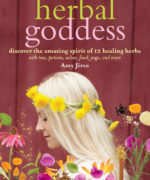In Herbal Goddess you’ll discover or re-discover that sense of taste and the energetics of herbs that relates to qualities we recognize—herbs of the sun, of romance, for detoxifying, relaxation, treating dis-ease, adapting, and healing on many levels.
Herbal Goddess: Discover the Amazing Spirit of 12 Healing Herbs with Teas, Potions, Salves, Food, Yoga, and More. / Amy Jirsa, 2015. Storey Publications. Illustrations in color. Appendices. Index. 
Leaves, flowers, fruits, seeds, and sometimes stems, twigs, barks and roots are the plant parts named as the most efficacious for healing and well-being tonics. These are items you expect to find in most herbals, but Amy Jirsa’s Herbal Goddess offers a bit more. You’ll find each herb covered in story-like format, as in how you and the herbs can interact. You’ll get to know there’s a celebratory relationship you can have with each of the 12 herbs in the book’s pages.
In Herbal Goddess, you’ll read prose about each herb “for the body”, “for the mind” and “for the soul” plus specifics about the healing and other effects of that herb. You’ll see which teas remedy poor digestion or insomnia for example, followed by body care. Each herb is featured in recipes for everything from sweet treats, to vinegar, pesto, salad, tea bread, latte, ice cream, and pickles. Each herbal profile is completed with a yoga pose specifically suited to the energy of that herb.
Most accounts of an herb’s properties include traditional, herb-specific information, or the short form of a plant’s characteristics for quick reference. Herbal Goddess is no exception, just in case you were wondering how far off the traditional mark a creative herbalist can go. In the quick reference for each herb—beginning with chamomile, then rose, dandelion, lavender, turmeric, echinacea, holy basil, nettle, calendula, elder, cinnamon, and ginger—you’ll find the common name, botanical name, parts used, its uses and effects on the mind and body, and safety considerations, even when to pick or gather from a garden or the wild.
Of the more delicate aspect of healing, strengthening and protection with botanicals—it’s your body, mind and soul that benefit from the holistic experience with an herb. At least the way 12 such herbs in Jirsa’s Herbal Goddess are described.
Did you know that an herbal flower, such as the rose, suspended in liquid which looks like clear water, transmits healing essence, even though it’s not possible to see it? Does healing essence have to do with, for instance, a rose’s fragrance or taste? Actually, the essence is vibrational, not really physical in nature. So, when you swallow a few drops of rose essence, you’re ingesting a powerful substance that’s beyond physical in its healing magic.
Jirsa’s recipes and instructions extend to flower essences. These are given generally for any herbal flower. To start, you should have access to fresh flower petals, a bowl of water and sunlight. If these are available, you can cultivate your own flower essence in a few hours of daylight. Capture the pure essence, decant it to a “dark glass bottle”, add brandy, cap. And, Viola! Your essence is ready for use (with a bit more water and brandy).
Jirsa even speaks of protection, by the plant, for you, as a wearer of perhaps a small satchel of the petals or flowers or leaves, for the flower’s magical spell-casting ability. It’s all at that stage of wonder and possibility that unites the soul with powers of the plant world.
Author Jirsa chooses physical play in yoga poses to reinforce the character of an herb’s essence, another avenue of exploration and joy with each herb. For Holy Basil, it’s Cobra Pose; for Chamomile, it’s a standing back-bend, or anuvittasana. And rose’s is “melting heart Pose” or anahatasana, ending with Child’s Pose. And more of course, there’s a pose for each of the 12 herbs
Herbal Goddess is a bit unique in scope. As true to the nature of herbals as it is, Herbal Goddess is not solely a manual for tucking into your backpack on plant walks. Indeed, it might be most helpful as a guide to the lesser known aspects of herbalism, the ones that share plant secrets—meaning, the deeper knowledge of the use of herbs for health and wellness.
Amy Jirsa’s website Quiet Earth Yoga has more insight into herbalism, its magic, and yoga.



